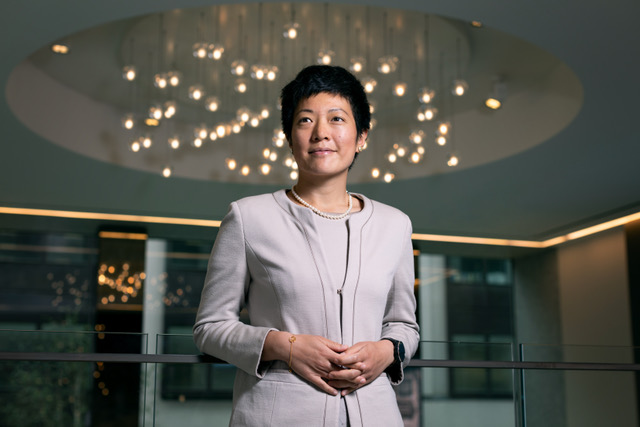Floods, wildfires, and other extreme weather events continue to make the headlines. The harsh reality of global warming faces us all with an accelerating search for solutions to a raft of climate change issues. Financial institutions across the globe are rising to the challenge, taking responsibility for finding and funding those solutions.
J.P. Morgan Asset Management is one of the companies addressing the challenges posed by climate change. LFF sat down with their Global Head of Sustainable Investing, Jennifer Wu and Portfolio Manager, Sara Bellenda, to learn more about their Luxembourg based Climate Change Solutions Fund.
This fund seeks to invest in forward-thinking companies that develop products and services which directly contribute to the carbon-cutting agenda of the Paris Agreement.
Could you explain what makes your Climate Change Solutions Fund sustainable and share some insights of the fund’s investment thesis?
Sara:
The fund aims to achieve returns by investing in companies with exposure to innovative climate change solutions. If you think about the Paris Agreement, we’re investing in companies that are helping to reduce carbonisation. We’re talking about $140 trillion of green CapEx required for us to decarbonise. The companies we look at tap into this market. The fund is unconstrained in nature and all cap. This means we can go anywhere.
Our starting point is to identify the key drivers of climate change. Where are our greenhouse gas emissions coming from? We then look at the solutions that are being developed to mitigate these drivers and grouped them into five categories.

Renewable energy and electrification are clearly important. Consumption of fossil fuels as a form of energy drives nearly 75% of annual greenhouse gas emissions. We look at companies that include sourcing their revenue from the generation of solar electricity or wind power for example. We also go a level deeper, investing in companies that provide the equipment needed for the production of renewable energy such as wind turbine suppliers.
Then there is sustainable construction. Buildings, both commercial and residential, are a major source of greenhouse gas emissions. We look at the way buildings are heated, ventilated and air conditioned (HVAC). All major consumers of energy. Upgrading HVAC systems in an office or home can lead to a meaningful reduction in the carbon footprint. But also, companies that are involved in LED lighting, roof and wall insulation and heat pumps.
Sustainable water and food is another important theme. The global agriculture system contributes over 20% of global greenhouse gas emissions. Here we look at companies that invest in precision agriculture; innovative technologies that allow farmers to optimise the use of land and improve crop yield through efficient use of resources.
And then there is sustainable transport. In this case we are talking about the transition to electric vehicles, but also the way we could move in the future.
And then there is sustainable transport. In this case we are talking about the transition to electric vehicles, but also the way we could move in the future.
And lastly, recycle and reuse, is the final theme within the portfolio. We’re increasingly seeing companies encouraging a shift towards a more circular economy. Deposit schemes for plastic bottles is a good example of how the circular economy is being put into practice. Recycle and reuse is an area with enormous growth potential but also an area that will largely be determined by the direction of regulation.

Deposit schemes for plastic bottles is a good example of how the circular economy is being put into practice.
How do you analyse such a large pool of potential investments?
Sara:
We use Artificial Intelligence and Big Data, in the shape of our proprietary natural language processing tool, ThemeBot. ThemeBot screens nearly 13,000 stocks globally, analysing tens of millions of data sources, as the tool identifies companies that are acting on climate change. Our research analysts then assess the fundamental investment case for each of the stocks identified by ThemeBot. We draw on these insights, as well as the climate change insights and stewardship experience of our Sustainable Investing team, to then build a high-conviction unconstrained portfolio of companies leading the way in delivering climate change solutions.
Are there any types of companies that are core to your investment pipeline?
Sara:
There are companies that are not quite mass market yet but are starting to push boundaries. We see these companies and their solutions as sitting within an ‘emerging’ phase. Importantly, these solutions have not yet reached cost parity which is what will increase their rate of adoption. These companies have high growth potential but are generally riskier, so we tend to take smaller positions.
Deere is a good example of an established company that is transitioning to selling ‘emerging technologies’ alongside traditional machinery. They’ve moved beyond what the market generally knows them for i.e., selling tractors. They’re now also involved in developing technology that enables farmers to improve crop yields, using GPS data to determine which seed should be planted and where, which crop requires pesticide or not and so on. The opportunity here is very exciting because it’s still early stage.
Then we get to the ‘mass adoption’ phase. Here, think of electric vehicles or high efficiency air conditioning systems which are meaningful in terms of the impact they can have on decarbonising buildings. The conditioning systems we installed 10 years ago are nothing like the ones we use today. And by just upgrading those components, we can make a meaningful impact.
And lastly, there’s those climate change solutions that have reached a ‘mature’ phase where there’s a great adoption rate. If we stick with buildings, LED lighting is a good example of this. It has a very high payback but is also very easy to do.

The conditioning systems we installed 10 years ago are nothing like the ones we use today. And by just upgrading those components, we can make a meaningful impact.
During the investment process, how do you appropriately integrate ESG risks?
Jennifer:
Our analysts need to answer 40 ESG risk-related questions for each company. And a big part of that is climate-related. This allows us to understand how exposed a company is to potential policy, technology or changing consumer behavior types of risks.
Sara:
In an ideal world, we want to be able to assess the impact these companies are having in terms of the carbon emissions their customers are either avoiding or reducing, thanks to the solutions being provided. We’re not quite there yet but are finding some companies are moving in this direction. Our analysts also work on materiality questions too. These are items or components that really are pertinent to a specific sector. For example, labour relations in mining.

In an ideal world, we want to be able to assess the impact these companies are having in terms of the carbon emissions their customers are either avoiding or reducing, thanks to the solutions being provided.
Engaging with companies and shareholders is important. Especially when targeting larger companies who are shifting towards less carbon intensive operations. Which steps do you take?
Jennifer:
We take a two-pronged approach. On the one hand, we have a dedicated investment stewardship team, with specialists around the world. That team focuses on between 20 to 50 companies in every region, that require intensive engagement. The conversation usually goes both ways though. It’s not, “you need to decarbonisese, tell me your target”, but here’s the reason why you need to reduce methane and some of the approaches that you can take to do so.” This type of engagement is critical, not only for the company, but also the stakeholders. Meeting companies frequently and really doing your homework are two key success factors.
The other type of engagement we do on a day-to-day basis is the analysis we have already talked about, where we design a specific engagement framework that Sara and our research analysts can use which really focuses on climate change solutions. We want to make sure, for example, that if we identify an early phase solution provider they will actually deliver. And if they come across any challenges, we want to know early on.

What are some of the opportunities and challenges that investors are currently facing in terms of sustainable investing?
Jennifer:
I think number one – and it’s really relevant to this fund – is that we see the adoption of many more climate-focused policies and regulations. This is creating what I regard as transformational shifts. There is room for improvement when it comes to climate policies but if you look back just three years, there have been a lot of positive developments.
The other thing to bear in mind is that technological investment is actually happening a lot faster than you might think. When you mention climate change solutions, I think a lot of people think of renewable energy, electric vehicles and so on. Examples such as Deere don’t tend to come up. But in fact, you have a lot of very interesting innovation in areas such as precision agriculture or air conditioning. This is not something you can see from a simple ESG score.
Why did you choose Luxembourg as the location to domicile the fund?
Jennifer:
We have more than thirty years of on-the-ground experience in Luxembourg, managing, administering, and overseeing client assets. Given Luxembourg’s role as a cross-border hub it’s also where our European UCITS and Alternatives Funds business is domiciled.
Having a regulatory environment, fund administration and depositary ecosystem that allows for different kinds of innovation, including our Climate Change Solutions Fund, is going to be critical for the next phase of innovation in sustainable investing. We therefore think Luxembourg will continue to have an important role to play in providing and fostering an environment where such innovation in investment management is made possible.
In terms of the future of sustainable finance, what do you see as some of the key issues that the industry still faces?
Jennifer:
I think a big risk is still the limited understanding, globally, that climate risks are not some far off possibility. They are here, happening now. And I don’t think these risks – and opportunities – are always being systematically captured in investment processes, across asset classes. But, there is data out there for investors to take into consideration, albeit imperfect. Many individuals are still taking a ‘blanket’ approach by excluding entire sectors. Ultimately, this approach will prevent you from potentially participating in some exciting opportunities, which is why a detailed understanding of the potential risks and opportunities is so paramount.

I think a big risk is still the limited understanding, globally, that climate risks are not some far off possibility. They are here, happening now.